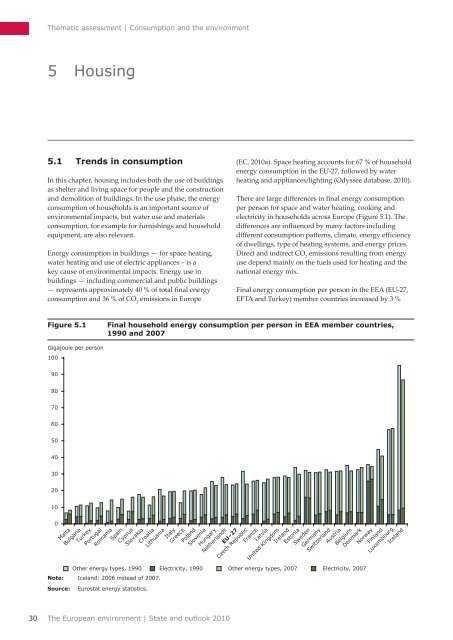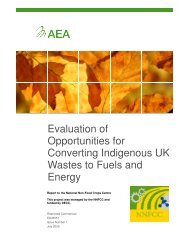Consumption and the environment (SOER2010) - European ...
Consumption and the environment (SOER2010) - European ...
Consumption and the environment (SOER2010) - European ...
Create successful ePaper yourself
Turn your PDF publications into a flip-book with our unique Google optimized e-Paper software.
Thematic assessment | <strong>Consumption</strong> <strong>and</strong> <strong>the</strong> <strong>environment</strong><br />
5 Housing<br />
5.1 Trends in consumption<br />
In this chapter, housing includes both <strong>the</strong> use of buildings<br />
as shelter <strong>and</strong> living space for people <strong>and</strong> <strong>the</strong> construction<br />
<strong>and</strong> demolition of buildings. In <strong>the</strong> use phase, <strong>the</strong> energy<br />
consumption of households is an important source of<br />
<strong>environment</strong>al impacts, but water use <strong>and</strong> materials<br />
consumption, for example for furnishings <strong>and</strong> household<br />
equipment, are also relevant.<br />
Energy consumption in buildings — for space heating,<br />
water heating <strong>and</strong> use of electric appliances – is a<br />
key cause of <strong>environment</strong>al impacts. Energy use in<br />
buildings — including commercial <strong>and</strong> public buildings<br />
— represents approximately 40 % of total final energy<br />
consumption <strong>and</strong> 36 % of CO 2<br />
emissions in Europe<br />
(EC, 2010a). Space heating accounts for 67 % of household<br />
energy consumption in <strong>the</strong> EU‐27, followed by water<br />
heating <strong>and</strong> appliances/lighting (Odyssee database, 2010).<br />
There are large differences in final energy consumption<br />
per person for space <strong>and</strong> water heating, cooking <strong>and</strong><br />
electricity in households across Europe (Figure 5.1). The<br />
differences are influenced by many factors including<br />
different consumption patterns, climate, energy efficiency<br />
of dwellings, type of heating systems, <strong>and</strong> energy prices.<br />
Direct <strong>and</strong> indirect CO 2<br />
emissions resulting from energy<br />
use depend mainly on <strong>the</strong> fuels used for heating <strong>and</strong> <strong>the</strong><br />
national energy mix.<br />
Final energy consumption per person in <strong>the</strong> EEA (EU‐27,<br />
EFTA <strong>and</strong> Turkey) member countries increased by 3 %<br />
Figure 5.1<br />
Final household energy consumption per person in EEA member countries,<br />
1990 <strong>and</strong> 2007<br />
Gigajoule per person<br />
100<br />
90<br />
80<br />
70<br />
60<br />
50<br />
40<br />
30<br />
20<br />
10<br />
0<br />
Note: Icel<strong>and</strong>: 2006 instead of 2007.<br />
Source:<br />
Malta<br />
Bulgaria<br />
Turkey<br />
Portugal<br />
Romania<br />
Spain<br />
Cyprus<br />
Slovakia<br />
Croatia<br />
Lithuania<br />
Eurostat energy statistics.<br />
Italy<br />
Greece<br />
Pol<strong>and</strong><br />
Slovenia<br />
Hungary<br />
Ne<strong>the</strong>rl<strong>and</strong>s<br />
EU–27<br />
Czech Republic<br />
France<br />
Latvia<br />
United Kingdom<br />
O<strong>the</strong>r energy types, 1990 Electricity, 1990 O<strong>the</strong>r energy types, 2007 Electricity, 2007<br />
Irel<strong>and</strong><br />
Estonia<br />
Sweden<br />
Germany<br />
Switzerl<strong>and</strong><br />
Austria<br />
Belgium<br />
Denmark<br />
Norway<br />
Finl<strong>and</strong><br />
Luxembourg<br />
Icel<strong>and</strong><br />
30<br />
The <strong>European</strong> <strong>environment</strong> | State <strong>and</strong> outlook 2010








